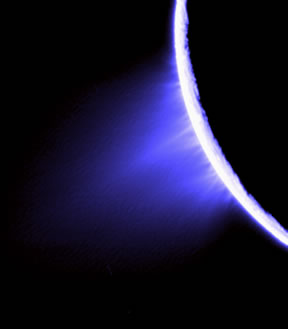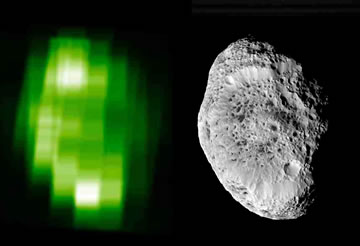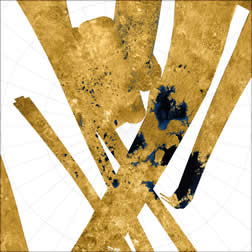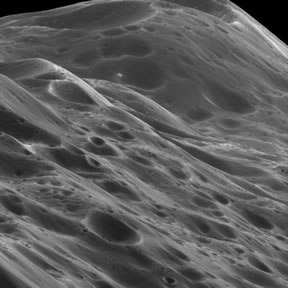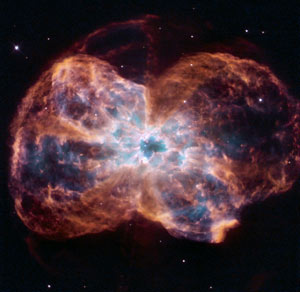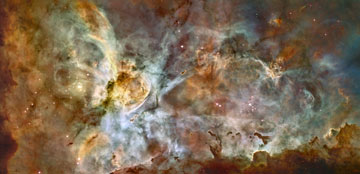|
HIGHLIGHTS — Planetary Exploration
2007 Highlights Home page >> Planetary Exploration Features >> Planetary Exploration Highlights
Other planets, other cores
Saturn Surprises
The 12 Months of Hubble
Planetary Exploration: Headline News Stories
Other planets, other cores
The four terrestrial planets — Earth, Mercury, Venus and Mars — have more in common with each other than with the gas giants farther out in the solar system, as each possesses a metallic core and a silicate mantle. But whether these planets are really similar to the core has been unclear. This year, however, researchers have gained some ground in getting to the heart of the terrestrial planets.
Earth’s core is divided into a solid metal inner core surrounded by a liquid metal outer core — in which the circulating fluid generates the planet’s magnetic field — but of the other terrestrial planets, Mercury and Venus have only weak magnetic fields, and Mars doesn’t have one at all (although it did in the past).
In May, astronomer Jean-Luc Margot of Cornell University in Ithaca, N.Y., and his team made a breakthrough discovery about the makeup of Mercury. Scientists had thought the planet’s core would be entirely solid, because the planet is so small that it radiates heat quite efficiently. How it would generate even a weak magnetic field without a liquid outer core, however, was a mystery. By studying and measuring tiny deviations in the planet’s spin, however, Margot and his team discovered that the planet must indeed have a liquid outer core (see Geotimes, July 2007). How it might remain liquid, despite the planet’s tiny size, remains a mystery — but small amounts of sulfur in the core would lower its melting point, keeping it liquid. That liquid core suggests that Mercury could have an Earth-like dynamo that may be producing its magnetic field, they wrote May 4 in Science. Many more of Mercury’s secrets will likely be revealed when NASA’s Messenger spacecraft begins orbiting the planet in 2011.
Neither Venus nor Mars show evidence of structured magnetic field lines such as those that surround Earth, suggesting that neither planet has a magnetic-field-producing dynamo. But while scientists think that toasty Venus is too hot to have a magnetosphere, and that its faint traces of magnetism are likely due to the interaction of the solar wind with its upper atmosphere (creating electrical currents that generate magnetism), Mars’ situation has been more puzzling. Four billion years ago, Mars had a magnetic field, but it shut off, leaving only remnant traces of magnetism in the crust of the planet. Now, scientists think they know why: Its entire core is molten — the planet doesn’t have a solid inner core, according to research by Andrew Stewart of the Swiss Federal Institute of Technology in Zurich, Switzerland, and colleagues (see Geotimes, August 2007). Both a molten and solid core are necessary to create a magnetic field-producing dynamo, Stewart says — but if the liquid core recrystallizes at some point, the red planet’s dynamo may someday switch back on.
Links:
"Mercury's gooey center," Geotimes, July 2007
“Earth’s core is solid, after all,” Geotimes, August 2007
"More on Mars," Geotimes, August 2007
Saturn Surprises
Sidebar: More about Cassini’s discoveries in the Saturnian system
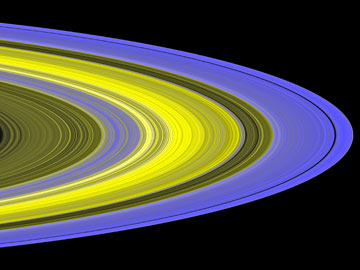 NASA/JPL/Space Science Institute |
“Orbiting Saturn, Cassini is in the middle of the greatest natural laboratory accessible to us in space,” said Dennis Matson, Cassini project scientist at NASA’s Jet Propulsion Laboratory, Pasadena, Calif., in a press statement on the anniversary of Cassini’s launch on Oct. 15. “With its rings, dozens of moons and magnetic environment, Saturn is like a mini-solar system, with Saturn as a stand-in for the sun, and the moons and rings like planets in formation.”
In addition to learning about Saturn’s many moons, researchers are learning more about the planet and its rings. For example, researchers think they have identified the source of Saturn’s strange G ring: large, icy particles that reside within a bright arc on the ring’s inner edge, Matthew Hedman of Cornell University in Ithaca, N.Y., and colleagues reported Aug. 2 in Science. The icy particles seem to be driven outward by electromagnetic forces, the researchers reported.
And in Icarus in May, Josh Colwell, a physicist at the University of Central Florida in Orlando, and colleagues reported that Saturn’s B ring, the planet’s largest and most densely packed ring, is composed of clumps of particles that are neatly organized and constantly colliding.
“We originally thought we would see a uniform cloud of particles. Instead we find that the particles are clumped together with empty spaces in between,” said Larry Esposito, principal investigator for the Cassini ultraviolet imaging spectrograph at the University of Colorado at Boulder, in a press statement May 22. Thus, scientists had previously underestimated the total mass of Saturn’s rings by as much as two or three times. “These results will help us understand the overall question of the age and hence the origin of Saturn’s rings,” Colwell said.
Cassini has also helped researchers learn more about Saturn’s moons in immeasurable ways, from determining why Enceladus has a tail to seeing the crater-pocked, walnut-shaped Iapetus up close for the first time.
The 12 Months of Hubble
This year the Hubble Space Telescope has imaged countless galaxies, exposed a few mysteries about our galaxy’s planets, and witnessed the birth, adolescence, golden years and death of stars. Here are a few examples compiled by the Space Telescope Science Institute, which runs Hubble.
In January, researchers observed a “blizzard” of particles in a disk around a young star, which illustrated how planets grow from tiny dust grains. The particles are about 10 times larger than typical interstellar dust grains. |
January |
|
||
On Feb. 6, Hubble captured the colorful death throes of a star like our sun. The star cast off its outer layers of gas, which had protected the core, making it glow (see Geotimes, October 2007). |
February | |||
In March, researchers pasted together more than 500 Hubble images taken over a year to create a “rich tapestry” of at least 50,000 galaxies near the Big Dipper. The panorama is yielding new clues about the universe’s early years and galaxy formation. |
March |
|
April |
In April, in celebration of Hubble’s 17th anniversary of deployment, researchers released a collector’s edition panoramic image of the central region of the Carina Nebula where stars are both being born and dying. | ||
May |
In May, astronomers discovered a ghostly ring of dark matter that formed 1 billion to 2 billion years ago when two massive galaxy clusters collided. Researchers said the discovery is the strongest evidence yet of dark matter. | |||
June |
In June, researchers measured the mass of Eris, the largest dwarf planet in our solar system. Eris is not only physically larger than Pluto, but it has 1.27 times its mass as well. |
July |
On July 17, Hubble captured a virtual parade of dust and debris moving in a misshapen ring around a young star, which researchers suggest may have been caused by the gravity of planets that orbit the star or by the gravity of a nearby star sweeping up debris. |
| August |
In August, researchers got their first good look at the dark side of Uranus’ rings, as the planet’s tilt changed and the rings could be seen edge-on. The new view revealed that the alignment of the planet’s rings is changing (see Geotimes, November 2007). |
September |
In September, researchers working with Hubble and the Spitzer Space Telescope discovered the smallest, most compact galaxies ever observed in the distant universe. Each of the newly discovered galaxies is a hundred to a thousand times smaller than the Milky Way. |
October |
In October, researchers discovered a galaxy nicknamed Dorian Gray, after the Oscar Wilde character that did not age, although his portrait did: The galaxy was previously thought to be very young due to its “youthful appearance,” but it is in fact an older galaxy with faint older stars. |
November |
In November, researchers revealed images Hubble took of a different kind of “dancing with the stars” — an intricate interaction between a pair of merging galaxies as stars, gas and dust flow from one galaxy, enveloping the other one, which appears as a rotating ring containing stars and gas clouds. |
December |
And for December’s image of the month, you’ll have to go to the Hubble Web site, at hubblesite.org. |
Links:
"Reaching for the stars in planet formation," Geotimes, October 2007
"New views of Uranus’ rings," Geotimes, November 2007
Planetary Exploration: Headline News Stories
Finding other Earths
Researchers continuously search for planets outside our solar system that resemble Earth, seeking planets out there that can support life as we know it. On April 27, Stéphane Udry of Geneva University in Switzerland and colleagues reported finding the most Earth-like planet yet discovered outside our solar system. Gliese 581 c, as the planet is called, orbits its sun at just the right distance away to sustain liquid water and to date, is the most likely place to find extraterrestrial life. The planet is about 20.5 light-years from Earth and is 50 percent larger than Earth with five times Earth’s mass. It orbits a red dwarf star, which many researchers suggest is the best place to look for Earth-like planets due to the star’s lower intensity.
Udry et al., Astronomy and Astrophysics, April 27, 2007; ESO press release, April 25, 2007.
NASA mission to study magnetic storms
On Feb. 16, NASA launched multiple satellites into orbit around Earth, in a joint project with the Canadian Space Agency, to understand the colorful aurora borealis (Northern Lights) and potentially disruptive magnetic storms in the atmosphere. Researchers said they plan to use the spacecraft to solve the mystery of how magnetic storms occur in order to better predict their dynamic behavior, which may help prevent Earth-based electrical disruptions from such storms (see story, this issue). The mission also marked the largest number of scientific satellites ever sent into orbit aboard a single rocket.
Geotimes online, Web Extra, Feb. 16, 2007.
Sputnik’s Golden Anniversary
Sputnik, the world’s first artificial satellite, was launched Oct. 4, 1957, setting off the space race. Six years later, the first commercial communications satellite, Telstar, was launched. In the 50 years since its launch, humans have orbited Earth and walked on the moon, while unmanned spacecraft have visited Mars, Jupiter, Mercury, Venus and other planets, as well as flown by comets and even crash-landed on an asteroid. Meanwhile, satellites have filled the sky, performing tasks from earthquake monitoring and climate observations to personal automobile navigation.
ScienceDaily, Oct. 5, 2007; Geotimes, July 2007 (“July 10, 1962: Telstar launches age of satellite communications,” Print Exclusive ).
Space goes online
A number of new space-themed online resources have launched recently, from planetarium-type programs, such as Google Sky (earth.google.com/sky) and Stellarium (www.stellarium.org), to sites where visitors can participate in the science, such as Galaxy Zoo (www.galaxyzoo.org). At Stellarium and Google Sky (similar to Google’s previous and immensely popular sites Google Earth and Google Mars), users can peruse everything you can see in a night sky — and more — no matter what your vantage point. At Galaxy Zoo, visitors help Oxford University researchers classify galaxies from their home computers. The researchers will double-check visitors’ work, but from July 11 (when the site first came online) until Aug. 1 alone, visitors had classified more than a million galaxies.
Geotimes, September 2007; Geotimes, November 2007.

 Subscribe
Subscribe

